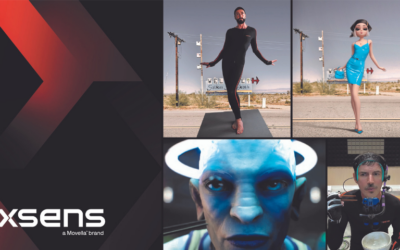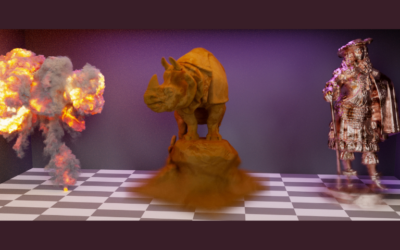SIGGRAPH 2024 is thrilled to welcome Keynote Speaker Dr. Dava Newman, director of the MIT Media Lab, Apollo Program Professor of Astronautics chair at MIT, and Harvard–MIT Health Sciences and Technology faculty member, to the stage this July. The former NASA Deputy Administrator will present on advanced space and climate computer graphics in “Humanity Becoming Interplanetary: Exploring Space for Earth.” Before you attend this fascinating keynote, learn more about Newman and how computer graphics plays a key role in humanity becoming interplanetary here.
SIGGRAPH: SIGGRAPH 2024 is thrilled to welcome you as a Keynote Speaker. What first interested you in “exploring space for Earth”?
Dava Newman (DN): Thank you, SIGGRAPH 2024, for the warm welcome. My fascination with exploring space for Earth began during my childhood in Helena, Montana. The Apollo program, particularly the Apollo 11 Moon landing, had a profound impact on me when I was just five years old. Watching humanity take those first steps on the Moon made me realize the boundless possibilities of human exploration. Also, it taught me to believe in the beauty of my dreams. This inspiration was coupled with my family’s aviation background — my father was a private pilot and my grandmother earned her private pilot’s license in the 1950s, which I didn’t know about until I was an aerospace engineer myself. These experiences instilled in me a passion for aerospace and a deep-seated belief that space exploration can bring invaluable benefits to Earth, from technological advancements to a better understanding of our own planet. Serving as NASA Deputy Administrator really instilled a sense of responsibility and urgency for me, and climate research enabled by machine learning and systems analysis became a major focus for me. It’s the most important challenge I can be working on.
SIGGRAPH: As NASA Deputy Administrator, you were instrumental in developing and articulating the Human Journey to Mars plan. Can you share insight into this plan and the role computer graphics and interactive techniques had in its development and execution?
DN: The Human Journey to Mars plan was an ambitious and multifaceted strategy aimed at advancing human space exploration beyond low Earth orbit. This plan involved several key phases: developing necessary technologies, conducting missions to the Moon as a proving ground, and ultimately sending humans to Mars to discover life (or past life). Computer graphics and interactive techniques were pivotal in this endeavor. They allowed us to create detailed visualizations of mission scenarios, spacecraft and habitat designs, and Martian outreach visions of the future. Interactive simulations and virtual reality environments were used for training astronauts, planning missions, and engaging with stakeholders and the public. These tools helped us to optimize mission parameters, enhance safety protocols, and communicate complex ideas effectively, ensuring the success of our vision for Mars exploration.
SIGGRAPH: Your research expertise is in aerospace biomedical engineering, investigating human performance across the spectrum of gravity and AI/ML. What breakthroughs and advancements are you seeing in these areas in relation to humanity becoming interplanetary?
DN: In aerospace biomedical engineering, we are witnessing significant breakthroughs that are crucial for humanity’s interplanetary future. Advances in AI and machine learning are revolutionizing how we develop and manage life support systems, enhancing astronaut health and performance. For instance, our work on the BioSuit™, a second skin spacesuit, leverages advanced materials such as carbon-doped polyethylene and AI-generative design to improve mobility and comfort for astronauts. Our experimental, analogy environment, and simulation research helps to understand and mitigate health risks associated with long-duration space travel, such as muscle atrophy and bone density loss. Additionally, our research on the Gravity Loading Countermeasure Skinsuit has shown promise in mitigating the adverse musculoskeletal and neurosensory effects of microgravity. These innovations are not only essential for space exploration but also have applications on Earth, such as in medical rehabilitation, soft robotics, and assistive devices.
SIGGRAPH: SIGGRAPH 2024 is interested in how computer graphics impacts the world on the smallest to the largest scales. How do you and your work push the boundaries of what is possible to build the most desirable, technological future?
DN: At the MIT Media Lab, we are at the forefront of pushing technological boundaries using computer graphics, VR/XR, wearable technologies, IoT, and related technologies. Our projects range from creating immersive virtual reality environments for astronaut training to developing detailed visualizations of Earth’s climate systems using ML and supercomputing. These technologies enable us to model complex phenomena, enhance human-machine interactions, and create compelling narratives that inspire action. By integrating computer graphics with advanced data analytics and machine learning, we are able to visualize and address global challenges, from space exploration to climate change to health and wellness. This interdisciplinary approach incorporating art-science-engineering-design helps us realize a future where technology not only solves problems, but also enhances human capabilities and inspires a flourishing future for all.
SIGGRAPH: What is one key takeaway you hope SIGGRAPH 2024 participants uncover from your keynote, “Humanity Becoming Interplanetary: Exploring Space for Earth”?
DN: The key takeaway I hope participants take from my keynote is the profound interconnectedness between space exploration and life on Earth. By exploring space, we gain critical insights and develop technologies that can address some of our most pressing challenges on Earth, such as climate change, resource management, health and wellness in isolated, confined environments, and sustainable living. Space exploration drives innovation, fosters international collaboration, and inspires us to think beyond our current limitations. I want to inspire participants to see space exploration not just as a distant dream, but as a vital pathway to ensuring a sustainable and thriving future for all of humanity. By embracing the spirit of exploration, we can build a better world both on Earth and beyond.
Learn more about Dr. Newman’s SIGGRAPH 2024 Keynote Presentation on our website, and register now to attend this session on Tuesday, 30 July at SIGGRAPH 2024.
Dr. Dava Newman is the director of the MIT Media Lab, holds the Apollo Program Professor of Astronautics chair at MIT, and is a Harvard–MIT Health Sciences and Technology faculty member. She served as NASA Deputy Administrator (2015–2017). Nominated by President Barack Obama and confirmed by the U.S. Senate unanimously in April 2015, Dr. Newman was the third woman and first female engineer and scientist to serve in this role. During her tenure, she made significant impact on NASA’s human exploration, specifically developing and articulating the Human Journey to Mars plan, highlighting scientific missions, advocating for transformative aeronautics capabilities, developing and implementing a strategic innovation framework, and advocating for diversity and inclusion for NASA and the nation’s STEM initiatives. Dr. Newman’s research expertise is in aerospace biomedical engineering investigating human performance across the spectrum of gravity and AI/ML for the dual challenge of energy and climate. She is a leader in advanced space suit design, astronaut performance, climate modeling and visualization, leadership development, innovation, and space policy. Dr. Newman was the principal investigator on five spaceflight missions. Her keynote will cover the theme of “Humanity Becoming Interplanetary: Exploring Space for Earth” and presents advanced space and climate computer graphics.



